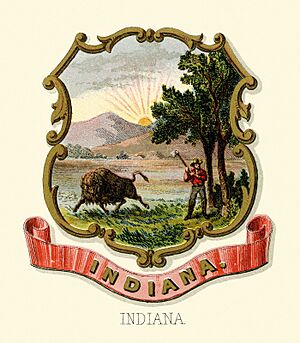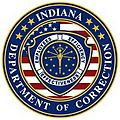Seal of Indiana facts for kids
Quick facts for kids Seal of Indiana |
|
|---|---|
 |
|
| Armiger | State of Indiana |
| Adopted | 1816 |
The Seal of Indiana is a special symbol used by the governor of Indiana. It helps to make official documents from the U.S. state of Indiana truly valid. This seal has changed a few times over the years. It started when Indiana was part of the Northwest Territory.
The first seal, which looks a lot like the one used today, was probably created by William Henry Harrison. He was the governor of the Indiana Territory back then. The way the seal looks now was officially decided by the Indiana General Assembly in 1963.
Contents
What the Indiana Seal Is Used For
The Governor of Indiana is in charge of keeping the state seal safe. This important seal is used to show that official state papers are real and approved.
You can find the seal on many documents. These include reports from state departments and laws that the Governor signs. It also appears on official messages from the Governor to other important leaders. The seal is also put on all official appointments given by the state. This shows that the appointment has real power and authority.
The History of Indiana's Seal
Back in 1792, the United States Congress passed a law. It told the United States Secretary of State to make seals for all the public offices in the territories. Indiana was part of the Northwest Territory at that time. So, the United States Department of State created a seal for official papers there. Governor Arthur St. Clair used this first seal. It was first recorded on July 26, 1788.
In 1800, the Indiana Territory was created. But the law didn't say anything about a new official seal. The first time we know the Indiana Territory's seal was used was in January 1801. It was on court papers signed by Governor William Henry Harrison. The seal he used was a changed version of the Northwest Territory's seal. We're not sure who changed it, but it was probably Harrison himself.
When Indiana became a state in 1816, its first constitution said the governor must have a state seal. This seal would be used for official messages. The idea for the seal's design came up during the first meeting of the Indiana General Assembly in 1816.
On November 22, 1816, a representative named Davis Floyd suggested a design. He described it as "A forest and a woodman felling a tree." It also had "a buffalo leaving the forest and fleeing through the plain to a distant forest." And finally, "sun in the west with the word Indiana." Lawmakers agreed and set aside money to make the seal.
In 1819, the state seal was part of a big problem. Governor Jonathan Jennings was away talking with Native American tribes. So, Lieutenant Governor Christopher Harrison became acting-governor. When Jennings came back, Harrison didn't want to give up being governor. He claimed Jennings' actions made his governorship invalid. Harrison took control of the state seal. He even set up his own governor's office. After weeks of arguments in the state legislature, Harrison had to give the seal back to Jennings. He also had to leave the governor's office. This showed how important the seal was as a symbol of who was truly in charge.
Later, in 1895, a clerk named Robert S. Hatcher looked into the seal's legal status. He found that the laws about the seal didn't clearly say what it should look like. He suggested a new law to make the design official. But nothing happened with that idea at the time.
In 1905, an article in the Indianapolis News talked about the seal's history. It made people wonder if the sun on the seal was rising or setting. Jacob Piatt Dunn, a famous Indiana historian, looked into it. He decided the sun was rising. He said Indiana was a young state, and the mountains were to the east. This meant the sun was coming up, not going down.
The current design of the seal was officially set by the Indiana General Assembly in 1963. Representative Taylor I. Morris introduced a bill to make the design standard. His bill described a woodsman cutting down a sycamore tree. An American bison runs in front, and the sun sets in the background. The border of the seal was to have leaves from the state tree, the tulip tree. This bill passed and became law.
In 2004, people started talking about the 1963 law. It said the sun on the seal was setting. But historical research showed the original seal was meant to have a rising sun. Bills were introduced in 2004 and 2005 to fix this wording. However, as of 2008, no changes had been made to correct this detail in the law.
What the Seal Looks Like and Means
The official seal of Indiana is a perfect circle. It is about two and five-eighths inches wide. Inside this circle is another circle, a bit smaller, with a beaded line around it. In the top part of the outer circle, it says "Seal of the State of Indiana." At the bottom, it has the year "1816."
Inside the main circle, you can see a picture. There are two trees on the left side in the background. In the middle background, there are three hills. A nearly full sun is shown setting behind and between the first and second hill from the left. This sun has fourteen rays.
On the right side, there are two sycamore trees. The bigger one is closer to the center. It has a cut in it, almost halfway through, a little above the ground. A woodsman is wearing a hat and holding his ax. He is standing near the tree.
In the front of the picture, there is a buffalo. It is facing to the left. Its tail is up, and its front feet are on the ground. Its back feet are in the air as it jumps over a log. The ground around the buffalo and woodsman has shoots of blue grass.
The symbols on the seal have special meanings:
- The sun rising (even though the law says setting) means that Indiana has a bright future. It shows the state is just beginning and growing.
- The mountains in the background represent the Allegheny Mountains. This shows that Indiana is located in the western part of the country.
- The woodsman represents people building civilization. He is taming the wild land that Indiana once was.
- The buffalo represents the wilderness. It is moving westward, away from the growing civilization.
Government Seals of Indiana
See also
 In Spanish: Sello de Indiana para niños
In Spanish: Sello de Indiana para niños








